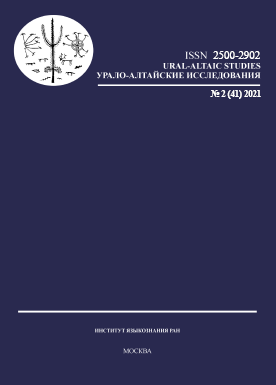К ТИПОЛОГИИ ИМПЕРАТИВА: СЕМАНТИКА ПРИИМПЕРАТИВНЫХ МАРКЕРОВ В ГОРНОМАРИЙСКОМ ЯЗЫКЕ
TOWARDS THE TYPOLOGY OF IMPERATIVE: SEMANTICS OF IMPERATIVE MODIFIERS IN HILL MARI
Author(s): Daria MordashovaSubject(s): Theoretical Linguistics, Morphology, Syntax, Semantics, Pragmatics, Finno-Ugrian studies
Published by: Институт языкознания Российской академии наук
Keywords: imperative modifiers; Hill Mari; semantics; pragmatics;
Summary/Abstract: The paper considers three modifiers that can be combined with the imperative in Hill Mari (Mari < Uralic): two imperative-specific modifiers (a clitic =aj and a suffix -ə̑ma) and a transcategorical particle =jä. These modifiers interact with the semantics of imperative in different ways, and the paper aims to determine their semantic and pragmatic contribution. The lack of a clear mechanism for the crosslinguistic study of imperative modifiers (as well as markers of (non-)categoricity in general) made it necessary to suggest a set of factors that may be relevant when choosing a particular modifier. Based on typological works devoted to the semantics of the imperative, the following factors have been taken into account: type of the directive speech act, social status of the interlocutors, compatibility with specific directive contexts (jussive, prohibitive). Taking into account the selected parameters, semantic and morphosyntactic properties of the Hill Mari imperative modifiers are analyzed, and a possible semantic invariant for each modifier is proposed. As a result, one gets a clear-cut division of the modifiers into two classes: the first class is represented by modifiers that are sensitive to the type of speech act and demonstrate various semantic effects in the context of different speech act types. Within this group, =aj and =jä are contrasted to each other, focusing on different participants of the speech act (the addressee and the speaker, respectively). The marker -ə̑ma belongs to the second class and is opposed to other markers, since its use does not yield significant semantic effects in various speech acts, but it has some certain morphosyntactic constraints. Semantically, this marker is considered as a neutral means of attenuating the directive speech act.
Journal: Урало-алтайские исследования
- Issue Year: 2021
- Issue No: 02 (41)
- Page Range: 73-88
- Page Count: 16
- Language: Russian

